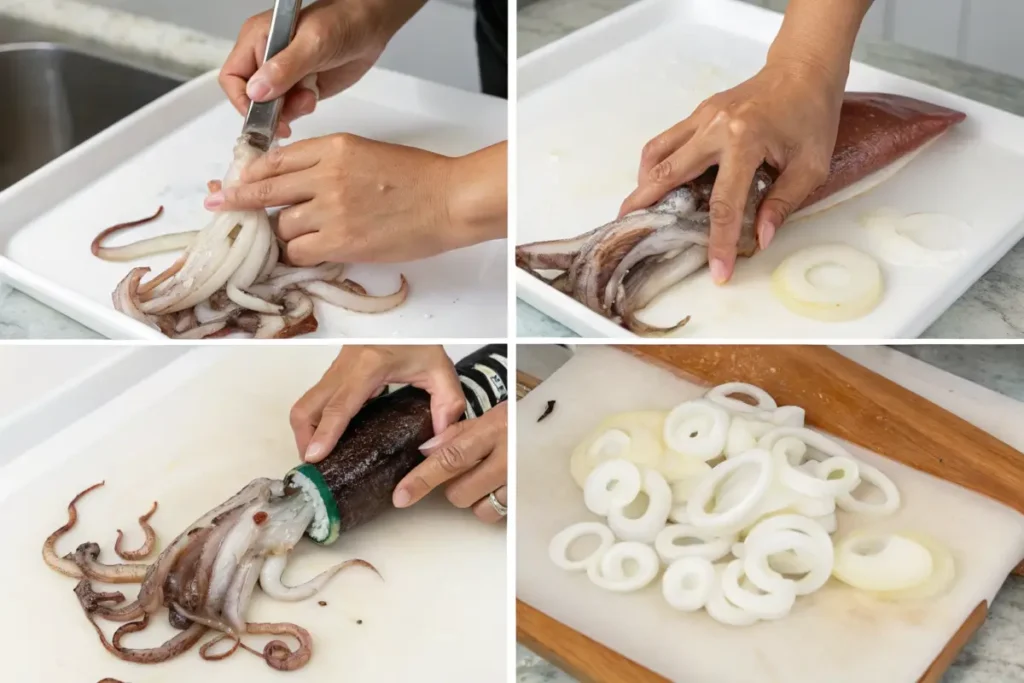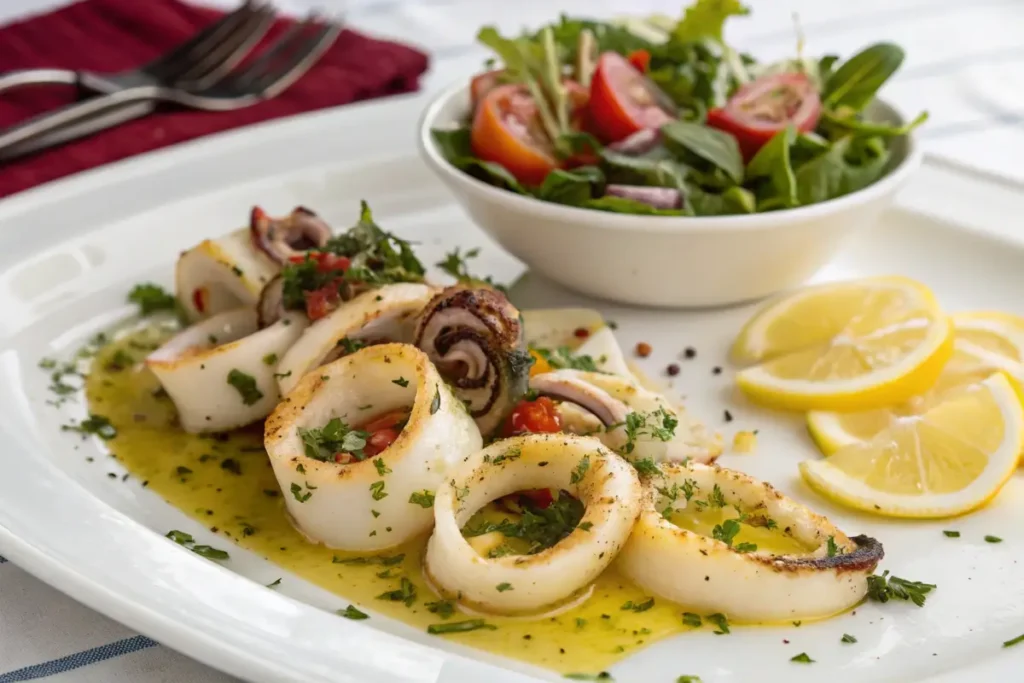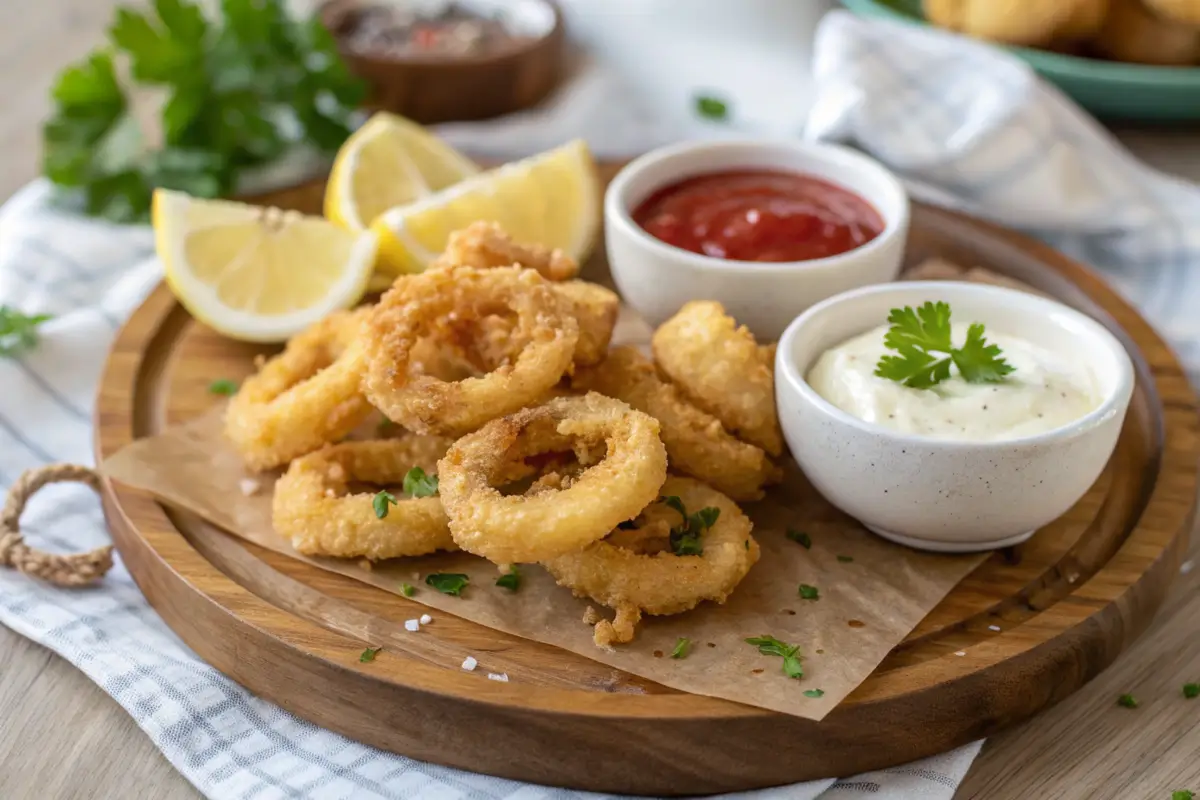What is calamari made of? If you’ve ever enjoyed crispy, golden rings of calamari at a restaurant, you may have wondered about its origins. Calamari is made from squid, a cephalopod found in oceans worldwide. This versatile seafood is known for its mild, slightly sweet flavor and tender texture, making it a favorite in many cuisines.
In this article, we’ll explore what calamari is made of, how it’s harvested, the best ways to prepare it, and its nutritional benefits. Whether you love it fried, grilled, or sautéed, you’ll gain a deeper appreciation for this popular seafood.
Table of Contents
What is Calamari?
this versatile seafood, pronounced kah-luh-mah-ree in Italian, refers to dishes that feature squid as the main ingredient. Its mild, slightly sweet flavor and tender texture make it a favorite among seafood enthusiasts worldwide. Whether chefs fry it into crispy rings, sauté it with flavorful spices, or grill it to perfection, squid shines in both casual and gourmet settings.
The Origin of the Term ‘Calamari’
The Italian term “calamari” comes from the Latin word calamus, meaning “reed pen.” Interestingly, this name likely reflects the squid’s long, slender body, which resembles an old-fashioned writing instrument. Additionally, many cooks use the term “calamari” to give squid dishes an exotic or refined appeal.
A Brief Overview of Its Popularity
This seafood has become a favorite appetizer and main course due to its flexibility and ability to complement a wide range of culinary styles. Mediterranean chefs toss it into fresh salads or stuff it with herbs, while Asian kitchens stir-fry it with bold sauces or roll it into sushi. Its quick cooking time also makes squid a favorite for busy home cooks and professional chefs looking to deliver flavorful meals in a flash.
With the groundwork laid, we’ll next explore the natural source of calamari—squid—and uncover what makes this creature so fascinating! Shall we continue?
Understanding the Source: Squid
Squid in the Animal Kingdom: Cephalopods Explained
Squid live within the fascinating cephalopod family, which includes octopuses and cuttlefish. These creatures display remarkable intelligence and possess unique biological traits, earning their place as some of the ocean’s most intriguing inhabitants. Unlike their shelled mollusk relatives, squid move with incredible agility and thrive in the open sea. Their streamlined bodies and fin-like appendages help them swim quickly, while their tentacles skillfully capture prey with precision.
Key Features of Squid
What makes squid stand out? Their anatomy includes several remarkable traits:
- Ten Arms and Tentacles: Squid have eight shorter arms and two elongated tentacles equipped with suction cups for catching and securing prey.
- Ink Sac for Defense: When threatened, squid release a cloud of ink to confuse predators and make a quick escape.
- Chromatophores for Camouflage: These specialized pigment cells enable squid to change their skin color, blending seamlessly into their surroundings.
Squid Habitats Across the Globe
Squid thrive in oceans worldwide, from shallow coastal waters to the deep sea. Thanks to their adaptability, they can populate various marine environments. As a result, this widespread distribution ensures a steady supply of squid for culinary uses, thus making squid a global delicacy.
Internal Link Opportunity: Learn more about this versatile seafood preparation techniques and recipes in Calamari Steak Made Easy: Tips, Recipes, Benefits.
From Squid to Calamari
Harvesting and Cleaning Squid
The journey of this versatile seafood starts when fishermen harvest squid from the ocean. Typically, commercial fisheries catch these creatures using nets or specialized lines. Once caught, workers clean the squid with care:

- Removing the Ink Sac and Organs: Workers remove the internal organs, including the ink sac, to prepare the squid for cooking.
- Separating Tentacles and Body: They detach the head from the body and carefully prep the tentacles for culinary use.
Common Forms of Calamari
Chefs prepare squid in several ways to create the squid dishes we know and love:
- Rings: They slice the squid’s tubular body into rings, which are the most familiar form of squid.
- Steaks: Thick cuts of squid work perfectly for grilling or sautéing.
- Tentacles: Often cooked whole or chopped, tentacles add a chewy texture and a unique flavor to dishes.
In summary, harvesting and preparing squid unlocks its potential for a variety of calamari dishes enjoyed around the world.
Fresh vs. Frozen Calamari
Both fresh and frozen squid are used to make squid. While fresh squid is ideal for its tender texture, frozen options are widely available and convenient for home cooking. Proper thawing is key to Keeping quality.
The process of Transitioning squid into calamari showcases the Ingredient’s usefulness Whether served as fried rings or tender steaks, calamari has become a staple in seafood cuisine.
Next up: We’ll uncover the myriad ways chefs prepare this versatile seafood around the world, highlighting the unique flavors and Compositions that make it a beloved seafood favorite!
Culinary Preparations of Calamari
Fried Calamari: The Classic Dish
When most people hear “calamari,” they picture crispy, golden rings served with a side of marinara or aioli. Fried squid is undeniably the most popular preparation. The secret lies in coating the squid rings in a light batter or breadcrumbs before deep frying. The result? A satisfying crunch that pairs perfectly with its briny, tender interior.
To boost its flavor, chefs often enhance fried squid with seasonings like paprika, garlic powder, or a squeeze of fresh lemon. Moreover, its versatility shines as it works beautifully as an appetizer, a bar snack, or even a crunchy topping for salads.
Other Cooking Methods
While frying is beloved, this versatile seafood can be prepared in many other ways:
- Grilled Calamari: This method is perfect for bringing out the natural sweetness of squid. Marinating the rings or steaks in olive oil, garlic, and herbs adds depth of flavor.
- Sautéed Calamari: this is sautéed with fresh vegetables, pasta, or sauces for a quick, flavorful meal.
- Baking and Roasting: This healthier option locks in the natural juices, keeping the calamari tender.
Global Recipes Featuring
Shines in global cuisines:

- Mediterranean: It appears in dishes like this versatile seafood stew or stuffed calamari, often seasoned with olive oil, tomatoes, and herbs.
- Asian: Stir-fried calamari with soy sauce, ginger, and chili is a favorite in many Asian dishes.
- Seafood Platters: Calamari complements shrimp, mussels, and other seafood in mixed platters and stews.
For more seafood recipe ideas, check out the guide to creating balanced seafood platters on our recipe page.
Flavor and Nutritional Profile of Calamari
What Does Calamari Taste Like?
Calamari stands out for its mild, slightly sweet flavor, a defining characteristic that many describe as delicate with a subtle oceanic hint. Because of this, its understated taste provides the perfect base for an array of seasonings and cooking techniques, thereby making it incredibly versatile in the kitchen.
The texture of squid varies with its preparation. Fried calamari delivers a crispy exterior with a tender chew, while grilling or sautéing gives it a firmer, meatier bite that pairs beautifully with bold marinades and spices.
Health Benefits of Eating Calamari
Calamari isn’t just delicious—it’s nutritious too! This seafood is a rich source of:
- Protein: Essential for muscle repair and energy.
- Vitamin B12: Supports the nervous system and helps produce red blood cells.
- Minerals: Selenium, an antioxidant, helps combat cell damage, while phosphorus promotes strong bones.
What’s more, calamari is low in fat and calories, making it a healthy addition to most diets. Just be mindful of how it’s prepared—frying adds extra calories, while grilling or baking keeps it light.
Next, we’ll explore essential tips for selecting and preparing calamari at home, and we’ll answer frequently asked questions to ensure your calamari creations turn out perfectly every time!
How to Choose and Prepare Calamari at Home
Buying Tips for Fresh Calamari
When shopping for this seafood, it’s important to know what to look for. Fresh options should have a mild, clean scent and firm, clear flesh. Avoid squid that smells overly fishy or feels slimy. Most seafood markets offer fresh varieties, but frozen alternatives work just as well when fresh isn’t an option. Frozen squid is usually flash-frozen to maintain its flavor and texture.
If you’re preparing a recipe that calls for tender calamari, selecting smaller squid is ideal since they tend to be more tender than larger ones.
Cleaning and Cutting Techniques
Cleaning calamari might seem intimidating, but it’s simpler than it looks. Start by rinsing the squid thoroughly under cold water. Next:
- Remove the head and tentacles, setting the tentacles aside for cooking if desired.
- Pull out the internal organs, including the ink sac and cartilage, from inside the body.
- Peel off the outer skin to reveal the smooth, white flesh beneath.
- Slice the body into rings or leave it whole for stuffing.
Once cleaned, calamari can be cooked in various ways. Proper cleaning ensures a fresh, tender result every time.
Common Mistakes to Avoid
Cooking calamari incorrectly can lead to a tough, rubbery texture. However, the secret lies in cooking it quickly over high heat (like frying or grilling) or very slowly (like stewing). On the other hand, medium cooking times often result in chewy calamari.
Frequently Asked Questions (FAQs)
Is Calamari a Type of Fish?
No, calamari isn’t a fish. Instead, it’s a type of mollusk that belongs to the cephalopod family, alongside octopuses and cuttlefish. In fact, the main ingredient in calamari dishes is squid, a soft-bodied marine creature.
How to Tell If Calamari is Fresh?
Fresh calamari should have a firm texture and a light ocean smell. If it smells overly fishy or appears slimy, it’s best to avoid it. Frozen calamari is also a reliable option, especially when thawed properly.
Can Calamari Be Eaten Raw?
Yes, calamari can be eaten raw, as seen in many sushi dishes. However, it must be exceptionally fresh and handled properly to minimize the risk of foodborne illness. Freezing squid before consuming it raw is often recommended to eliminate parasites.
What Are Some Alternative Cooking Methods for Calamari?
Beyond frying, you can grill, bake, roast, or sauté calamari. For instance, grilling brings out its natural sweetness and offers a healthy alternative, while stuffing it creates a hearty and flavorful meal.
By understanding what calamari is made of and mastering its preparation, you can unlock its full culinary potential and impress your guests with this versatile seafood. So, stay tuned for the conclusion, where we’ll tie everything together and wrap up this flavorful journey!
Conclusion and Culinary Inspiration
Why Calamari is a Versatile Seafood Option
This seafood’s versatility makes it a standout ingredient. Whether you enjoy it crispy and fried or grilled with a Mediterranean twist, it adapts beautifully to flavors from around the world. Its mild, slightly sweet taste and tender texture provide an excellent foundation for a wide range of dishes.
Here’s the revised version with more transition words:
Learning more about how it’s sourced—squid—further enhances the appreciation of this beloved delicacy. Moreover, from its fascinating journey in the ocean to your plate, it beautifully reflects nature’s finest offerings in a truly delicious way.
Creative Ways to Cook
This ingredient inspires creativity in the kitchen. Consider stuffing whole squid with flavorful fillings or adding sautéed pieces to a colorful pasta dish. Its quick cooking time makes it perfect for busy weeknights, while its sophistication makes it ideal for entertaining. Experiment freely with spices and marinades to match your taste preferences.
For more inspiration, check out our Calamari Steak Made Easy: Tips, Recipes, Benefits to elevate your culinary game.

